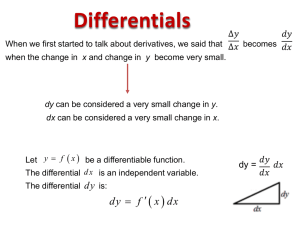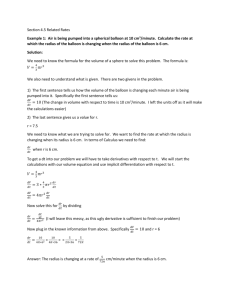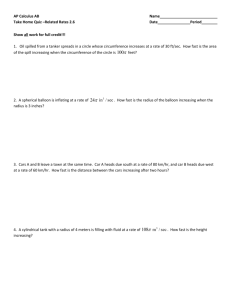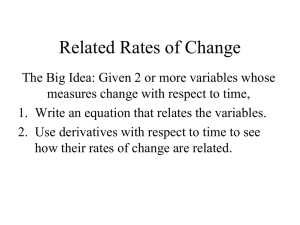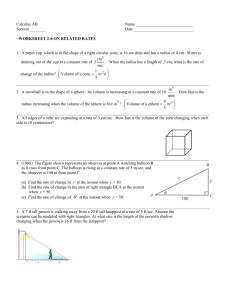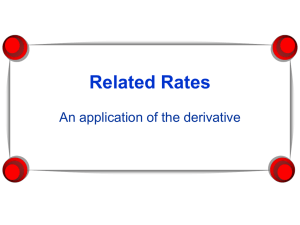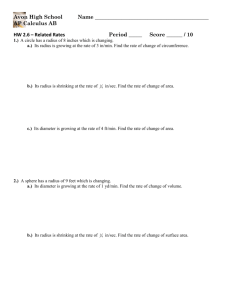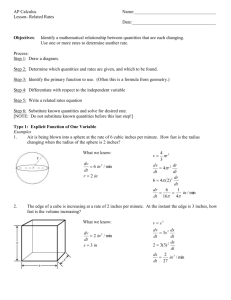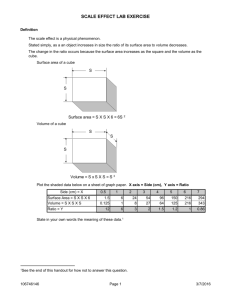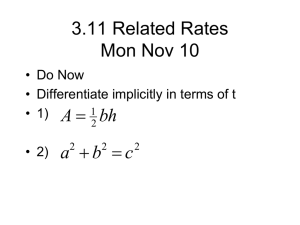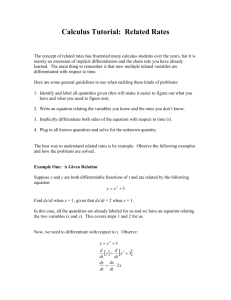14. RELAted rates - Uplift North Hills
advertisement
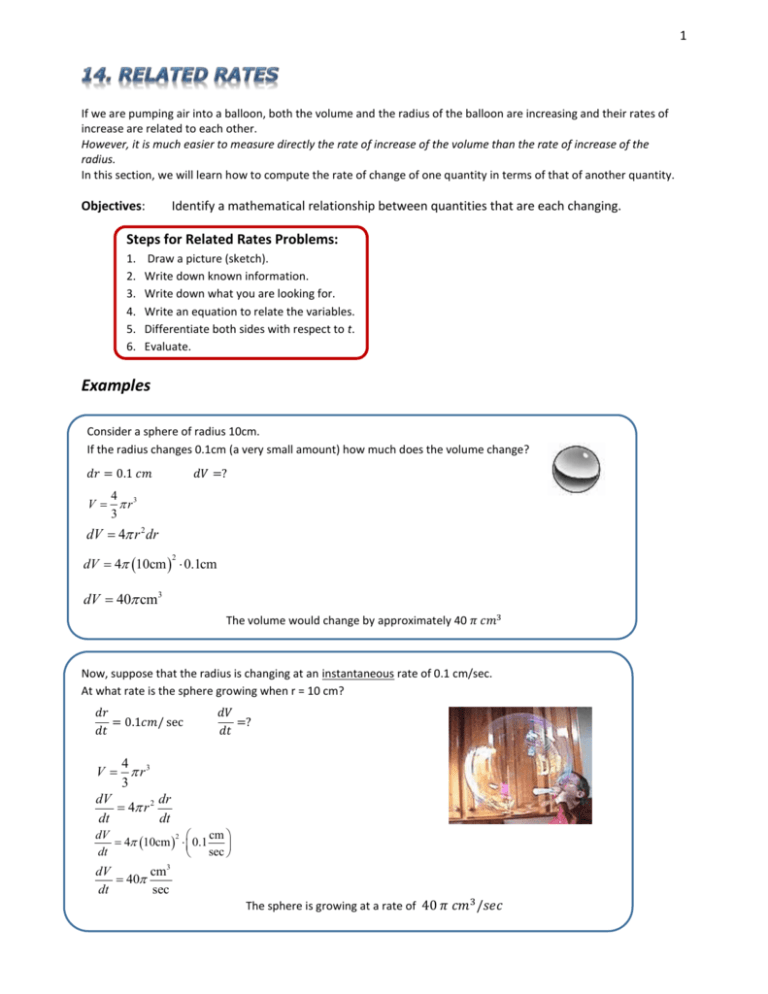
1 If we are pumping air into a balloon, both the volume and the radius of the balloon are increasing and their rates of increase are related to each other. However, it is much easier to measure directly the rate of increase of the volume than the rate of increase of the radius. In this section, we will learn how to compute the rate of change of one quantity in terms of that of another quantity. Objectives: Identify a mathematical relationship between quantities that are each changing. Steps for Related Rates Problems: 1. 2. 3. 4. 5. 6. Draw a picture (sketch). Write down known information. Write down what you are looking for. Write an equation to relate the variables. Differentiate both sides with respect to t. Evaluate. Examples Consider a sphere of radius 10cm. If the radius changes 0.1cm (a very small amount) how much does the volume change? 𝑑𝑟 = 0.1 𝑐𝑚 𝑑𝑉 =? 4 V r3 3 dV 4 r 2 dr dV 4 10cm 0.1cm 2 dV 40 cm3 The volume would change by approximately 40 𝜋 𝑐𝑚3 Now, suppose that the radius is changing at an instantaneous rate of 0.1 cm/sec. At what rate is the sphere growing when r = 10 cm? 𝑑𝑟 = 0.1𝑐𝑚/ sec 𝑑𝑡 𝑑𝑉 =? 𝑑𝑡 4 V r3 3 dV dr 4 r 2 dt dt dV cm 2 4 10cm 0.1 dt sec dV cm3 40 dt sec The sphere is growing at a rate of 40 𝜋 𝑐𝑚3 /𝑠𝑒𝑐 2 Air is being blown into a sphere at the rate of 6 cubic inches per minute. How fast is the radius changing when the radius of the sphere is 2 inches? What we know: 4 v r 3 3 dv dr 4r 2 dt dt dr 6 4 (2) 2 dt dr 6 3 in / min dt 16 8 dv 6 in 3 / min dt r 2 in Example: Air is being pumped into a spherical balloon so that its volume increases at a rate of 100 cm3/s. How fast is the radius of the balloon increasing when the diameter is 50 cm? 𝑑𝑉 𝑐𝑚3 = 100 𝑑𝑡 𝑠 𝑑𝑟 =? 𝑑𝑡 𝑤ℎ𝑒𝑛 𝑟 = 25 𝑐𝑚 4 V r3 3 𝑑𝑉 𝑑𝑉 𝑑𝑟 𝑑𝑟 = = 4𝜋𝑟 2 𝑑𝑡 𝑑𝑟 𝑑𝑡 𝑑𝑡 𝑑𝑟 1 𝑑𝑉 = 𝑑𝑡 4𝜋𝑟 2 𝑑𝑡 → 𝑑𝑟 1 1 = 100 = 𝑑𝑡 4𝜋(25)2 25𝜋 The radius of the balloon is increasing at the rate of 1/(25π) ≈ 0.0127 cm/s. The edge of a cube is increasing at a rate of 2 inches per minute. At the instant the edge is 3 inches, how fast is the volume increasing? What we know: dv 2 in 3 / min dt s 3 in v s3 dv ds 3s 2 dt dt ds 2 3(3) 2 dt ds 2 3 in / min dt 27 3 Water is draining from a cylindrical tank at 3 liters/second. How fast is the surface dropping? 3 cm dV L 3000 3 dt sec sec 𝑑ℎ =? 𝑑𝑡 V r 2h 𝑟 𝑖𝑠 𝑐𝑜𝑛𝑠𝑡𝑎𝑛𝑡! dV dh r2 dt dt dh dt cm3 sec r2 3000 Truck A travels east at 40 mi/hr. Truck B travels north at 30 mi/hr. How fast is the distance between the trucks changing 6 minutes later? @ 6 min x= 4 mi & y = 3 mi from initial position z2 = x 2 + y 2 𝑑 = 𝑣𝑡 @ 6 min z = 5 mi 𝑑𝑧 𝑑𝑥 𝑑𝑦 = 2𝑥 + 2𝑦 𝑑𝑡 𝑑𝑡 𝑑𝑡 𝑑𝑧 5 = 4 ∙ 40 + 3 ∙ 30 𝑑𝑡 𝑑𝑧 = 50 𝑚𝑖/ℎ𝑟 𝑑𝑡 2𝑧 Car A is traveling west at 50 mi/h and car B is traveling north at 60 mi/h. Both are headed for the intersection of the two roads. At what rate are the cars approaching each other when car A is 0.3 mi and car B is 0.4 mi from the intersection? dx / dt = –50 mi/h & dy / dt = –60 mi/h both x & y are decreasing 𝑑𝑧 =? 𝑑𝑡 z2 = x2 + y2 ⇒ 2𝑧 𝑑𝑧 𝑑𝑡 = 2𝑥 𝑑𝑥 𝑑𝑡 + 2𝑦 𝑑𝑦 𝑑𝑡 When x = 0.3 mi & y = 0.4 mi, z = 0.5 mi. 𝑑𝑧 1 [0.3(−50) + 0.4(−6)0] = 𝑑𝑡 0.5 𝑑𝑧 = −78 𝑚𝑖/ℎ 𝑑𝑡 4 A ladder 10 ft long rests against a vertical wall. If the bottom of the ladder slides away from the wall at a rate of 1 ft/sec, how fast is the top of the ladder sliding down the wall when the bottom of the ladder is 6 ft from the wall? What we know: dx 1 ft / sec dt r 10 ft x 6 ft x2 y2 r 2 dx dy dr 2x 2 y 2r dt dt dt dy (2 6 1) 2 8 0 dt dy 16 12 dt dy 12 3 ft / sec dt 16 4 The altitude of a triangle is increasing at a rate of 1 cm/min while the area of the triangle is increasing at a rate of 2 cm2/min. At what rate is the base of the triangle changing when the altitude is 10 cm and the area is 100 cm2? What we know: dh 1 cm / min dt dA 2 cm 2 / min dt h 10 cm A 100 cm 1 bh 2 1 100 b 10 2 b 20 cm 1 A bh 2 dA 1 dh db b h dt 2 dt dt A 2 1 db 20 1 10 2 dt db 1.6 cm / min dt A water tank has the shape of an inverted circular cone with base radius 2m and height 4 m. If water is being pumped into the tank at a rate of 2m3/min, find the rate at which the water level is rising when the water is 3 m deep. 5 What we know: 1 3 h 12 dv 1 dh h2 dt 4 dt 1 2 dh 2 3 4 dt r 2 h 4 h r 2 1 v r 2h 3 rbase 2 m htotal 4 m dv 2 m 3 / min dt h3m v 2 1 h v h 3 2 dh 8 m / min dt 9 A point moves along the curve y x 3 such that its x-coordinate is increasing at 4 units per second. 2 (a) At the moment x = 1, how fast is the y-coordinate changing? Interpret your answer based on the shape of the graph and the location of the point. (b) What we know: y x 3 dx 4 units / sec dt x 1 dy dx 2( x 3) dt dt dy 2(1 3) 4 16 units / sec dt 2 At the moment x = 1, how fast is the point’s distance from the origin changing? What we know: D ( x 0) 2 ( x 3) 2 0 2 2 dx D ( x) 2 ( x 3) 2 4 units / sec dt D x 2 ( x 3) 4 x 1 1/ 2 D x 2 ( x 3) 4 1 / 2 dD 1 2 dx x ( x 3) 4 2 x 4( x 3) 3 dt 2 dt 1 / 2 dD 1 2 (1) (1 3) 4 2(1) 4(1 3) 3 4 dt 2 dD 1 1 / 2 1 / 2 17 30 4 6017 14.552 units / min dt 2 Calculus Maximus PROBLEMS: 6 7 8
